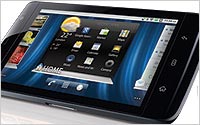Tablet, E-Reader Owners Double Over Holidays
- by Mark Walsh @markfwal, January 23, 2012

The share of U.S. adults who own tablet computers nearly doubled from 10% to 19% during the holiday season, fueled in part by the launch of less expensive devices like the Kindle Fire and Barnes & Noble’s Nook Tablet, according to a new study.
The research by the Pew Internet & American Life Project found that e-reader ownership also jumped from 10% to 19% between mid-December and mid-January, while the proportion of Americans with either type of device climbed from 18% to 29%.
The surge is all the more striking because it follows a period from mid-2011 into the fall, when there was little change in the growth of tablet and e-reader adoption. But following the rollouts of the $199 Kindle Fire and the $250 Nook Tablet in mid-November -- taking on the $499 iPad -- consumers began opening up their wallets in large numbers.
“In the time we have been doing surveys about the adoption and use of digital technology, we have never seen growth quite like this,” noted Lee Rainie, director of Pew’s Internet & American Life Project. “These findings have major implications for every media company -- especially book publishers, everyone in a knowledge business, and key community institutions like libraries. They show how radically the tectonic plates of information creation and dissemination are shifting under our feet.”
While Amazon has not revealed exactly how many Kindle Fires it sold in the fourth quarter, it said in December it was selling Kindle devices overall at a rate of 1 million a week. The Fire has been its top-selling product since it went on sale. Wall Street analysts had projected that Amazon sold as many as 5 million Kindle Fires in the quarter.
Barnes & Noble touted strong sales of its Nook devices over the holidays, although conceding Nook Tablet sales did not meet expectations. The company had said it is considering spinning off its Nook business a separate unit to capitalize on its growth as a digital media platform.
Apple's iPad has dominated the tablet category to date, accounting for roughly 60% of sales through the third quarter. It is rumored to be unveiling the latest version of its 10-inch device as soon as next month, prior to a March launch.
The new Pew findings should only heighten manufacturer expectations for tablet and e-reader sales in 2012.
The results were based on a series of surveys the research organization conducted between mid-November and early January. The December 2011 findings come from a sample of 2,986 people ages 16 or older surveyed between Nov. 16 and Dec. 21. A separate pair of surveys with two groups of about 1,000 adults 18+ was conducted from Jan. 5-8 and Jan. 12-15.
To help distinguish between tablets and e-readers, Pew asked in one survey question whether people owned “a handheld device made primarily for e-book reading, such as a Nook or Kindle e-book reading." Study participants were separately asked whether they had “a tablet computer like an iPad, Samsung Galaxy, Motorola Xoom, or Kindle Fire.”
The research found the jump in tablet adoption was especially notable among more affluent consumers -- households earning more than $75,000. More than a third of people (36%) in that category now own tablets, and almost a third (31%) with a college or higher education have one. Uptake of tablets was steepest among those under 50, with the 30-49 segment showing the highest growth, at 24%.
When it came to e-readers, women continue to be more avid buyers than men. Wealthier and better-educated people also are more like to have e-readers, but the gap between them and others is not as dramatic as with tablets.
For example, 19% of those in households earning $30,000-$50,000 have e-book readers compared to 31% of those in the $75,000-and-up income group. The gap between those income levels in relation to tablet ownership, by contrast, is 20 percentage points.


